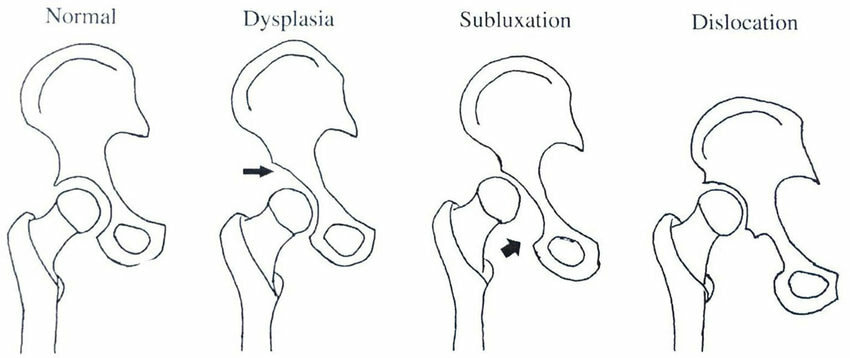|
Most people understand joint dislocations. But subluxations, or partial dislocations, are a bit different. As a myotherapist, I see plenty of subluxations and related injuries every week. So let’s look at why subluxations aren’t quite dislocations, and what you can do about them! What is a subluxation? Unlike a dislocation, a subluxation is a partial displacement of the joint. With a dislocation, the bone is completely out of the joint it belongs to. But with a subluxation, the bone is only partly out. Just because it is not a full dislocation doesn’t mean that it won’t hurt! Subluxation can still be painful, as the joint is being wrenched out of its usual spot. It can also leave you at higher risk of chronic pain if the joint isn’t rehabilitated after the injury. In the image above, we're looking at the ball and socket joint of the hip. The Normal hip joint shows the ball of the femur (thigh bone) sitting neatly inside the socket joint of the pelvis. In Dysplasia, the shape of the socket is not correctly formed so the socket doesn't snugly hold the ball of the femur. In Subluxation, the ball of the femur has partially slid out from the socket, and while its still almost in the right spot, it likely won't move smooth and painfree like the normal hip. And in the Dislocation, the ball of the femur has entirely moved out of the socket.
Why do joints sublux? It is easier for a joint to sublux than it is to dislocate. That being said, if you have full strength and integrity in your joints, it will take a high-impact injury to sublux a joint. This is usually something like a fall, car accident or a sports injury. However, some people are at a higher risk due to weak, unstable or unusually shaped joints. A previous history of dislocation or subluxation can weaken the joint and make it more prone to a sublux. People with hypermobile joints can sublux joints with minimal force, because the ligaments (connective tissue that holds the joint together) are more elastic than they should be. This can lead to the person being very flexible but also more prone to subluxations – some of my more hypermobile clients can sublux joints while walking, sitting, or even sleeping! You can also have variations in the shape of your hip or shoulder joints that make it easier to sublux. Hip dysplasia is one common variation that increases the risk of subluxing a hip joint, like in the image above. Joints at risk of subluxation In the clinic, I’ve seen almost every subluxation possible, thanks to my hypermobile clients! But there are several joints that are easier to sublux due to their location and structure:
If you have hypermobile joints, you may be at risk of subluxing other joints like ribs, jaw and collarbone. How is a subluxed joint rehabilitated? It can depend on the type of subluxation, and how it occurred. If it was due to high-impact trauma, there’s likely to be a decent amount of joint damage that needs attention. It could take weeks before the pain subsides enough to focus on rehabilitation. But if the sublux occurred due to hypermobility or dysplasia, it might just need a little TLC for a week or two. After that, the focus will be on building up the muscles that support the joint to reduce the risk of recurrence. Either way, the focus for rehabilitating the joint will include stabilising it, minimising any symptoms, and rebuilding the strength and integrity. What can a myotherapist do for subluxations? If you’re dealing with a subluxed joint (or multiple!), I’m here to help. Let’s look at how myotherapy can help with subluxations:
So don’t sit at home and feel sore after a joint has subluxed. Come see your favourite myotherapist. We’ll have you feeling better in no time! Click here to book an appointment. Comments are closed.
|
Meet Our Team
We have a team of great practitioners available 7 days a week at our Rowville clinic. Archives
July 2024
Categories
All
|
Got a question about Myotherapy?
Contact Mel by phone, email or Facebook
|
Simple Wellness Myotherapy & Remedial Massage Clinic
Shop 12B 150 Kelletts Rd Rowville VIC 3178 |
Phone us on
03 8204 0970 |


 RSS Feed
RSS Feed